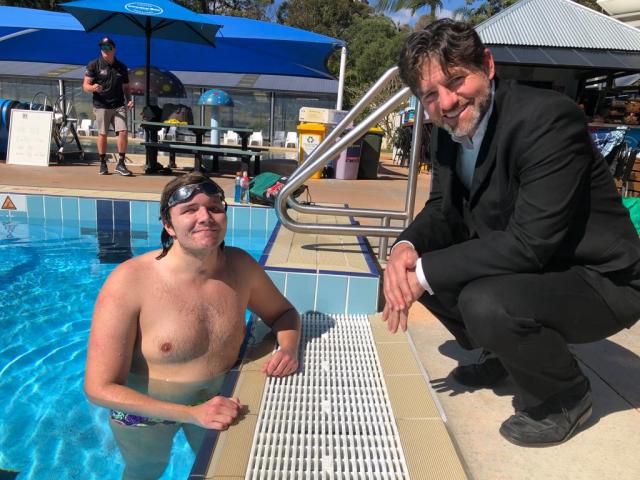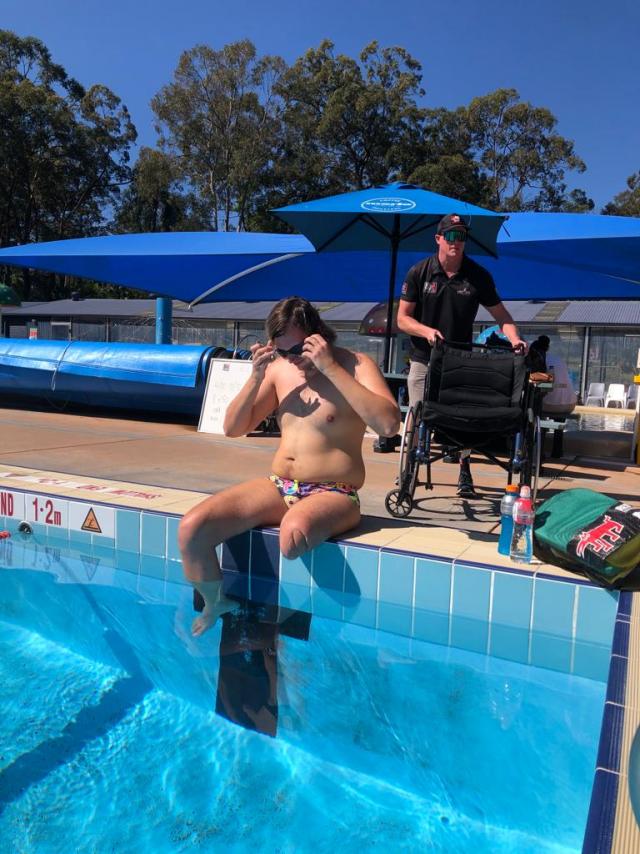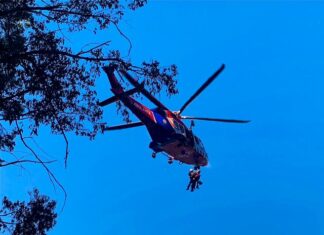A Brisbane man who underwent world-first implant surgery on his skull after suffering life-threatening head injuries in an overseas motorcycle accident is taking on a two-kilometre swim event in Noosa this weekend, tethered to his sister.
Three years on from the surgery, Brodie Ellis’s own skull has successfully regrown – via a 3D printed bioresorbable implant – and he has been training hard in the pool for this Sunday’s open-water Noosa Summer Swim.
Brodie, 28, sustained a traumatic brain injury in the 2018 accident in Vietnam, as well as a shattered left leg which eventually had to be amputated. He was also left with just 20 per cent vision in one eye.
“I can’t wait to get out into the ocean. Swimming gives me so much more mobility and freedom of movement, and this is a huge achievement for me,” Brodie said.
“I’ve had to work my way up to this event, initially starting with four months of private swimming lessons after my operation, then I moved to squad.
“I’ve been training four times a week – with Red Dog Triathlon squad, and by myself. I hope to one day swim for Australia.”
Brodie will be assisted into the deep water at the start of the Noosa Summer Swim, where he will be tethered to his 26-year-old sister, Sabrina, who will swim ahead as his guide.
“Sabrina is awesome, she’s a great swimmer in her own right, and I’m so grateful to have the support of my family and friends,” Brodie said.
Brodie underwent world-first surgery in December, 2019 with one of Australian-Singaporean company Osteopore’s bioresorbable implants for cranioplasty, after one of the two acrylic implants initially inserted caused a life-threatening infection.
After the Osteopore implant dissolved, Brodie’s own skull regrew, removing the need for him to wear a helmet and allowing him to return to his financial planning study and of course, swimming.
“Being the guinea pig for the implant surgery has definitely paid off… it’s really played out perfectly,” Brodie said.
“After my first infection with an acrylic plate, and then the ongoing dramas of having a gaping hole in my head and headaches, I am forever thankful the surgery with the implant was available as it has changed my life.”
Princess Alexandra Hospital plastic and reconstructive surgeon Dr Michael Wagels pioneered the 11-hour operation to replace Brodie’s missing section of skull, ultimately enabling it to regrow.
“The body recognised the implant as broken bone that needed to be healed… and the special thing about Brodie’s implant is that it is completely absorbable, so it disappears as the new bone forms within and around it,” he said.
Dr Wagels has been a solid support for the avid swimmer and the pair have formed a strong bond.
“Brodie is one of the most awe-inspiring and courageous people I know. He is a truly remarkable young man,” Dr Wagels said.
“Whatever is thrown at him, he gives it his all… in fact he puts most of us mere mortals to shame most of the time.”
Extensive planning was required prior to Brodie’s surgery to design and manufacture the implant, with the support of the Translational Research Institute (TRI), Australian Centre for Complex Integrated Surgical Solutions (ACCISS), and implant developer Osteopore.
Osteopore executive chairman Mark Leong said this surgery was ground-breaking in the regenerative medicine space and had life-changing effects for Brodie.
“We are heartened to see the huge differences this operation has made to Brodie’s life and wish him all the best in this weekend’s swim,” Mr Leong said.
“Australian doctors are increasingly looking for products that work with the body’s natural regenerative capabilities and replacing like with like, rather than having to rely on artificial replacement parts or some bone grafts reduces post-surgery complication rates significantly, compared to permanent implants.”
Brodie’s successful surgery sparked the beginning of a clinical trial out of Brisbane, to help similar patients. The results so far have revealed Osteopore’s technology has enabled the regrowing of large bone defects previously thought impossible – with major trauma sufferers, cancer patients, and people with congenital defects just some who can benefit.








